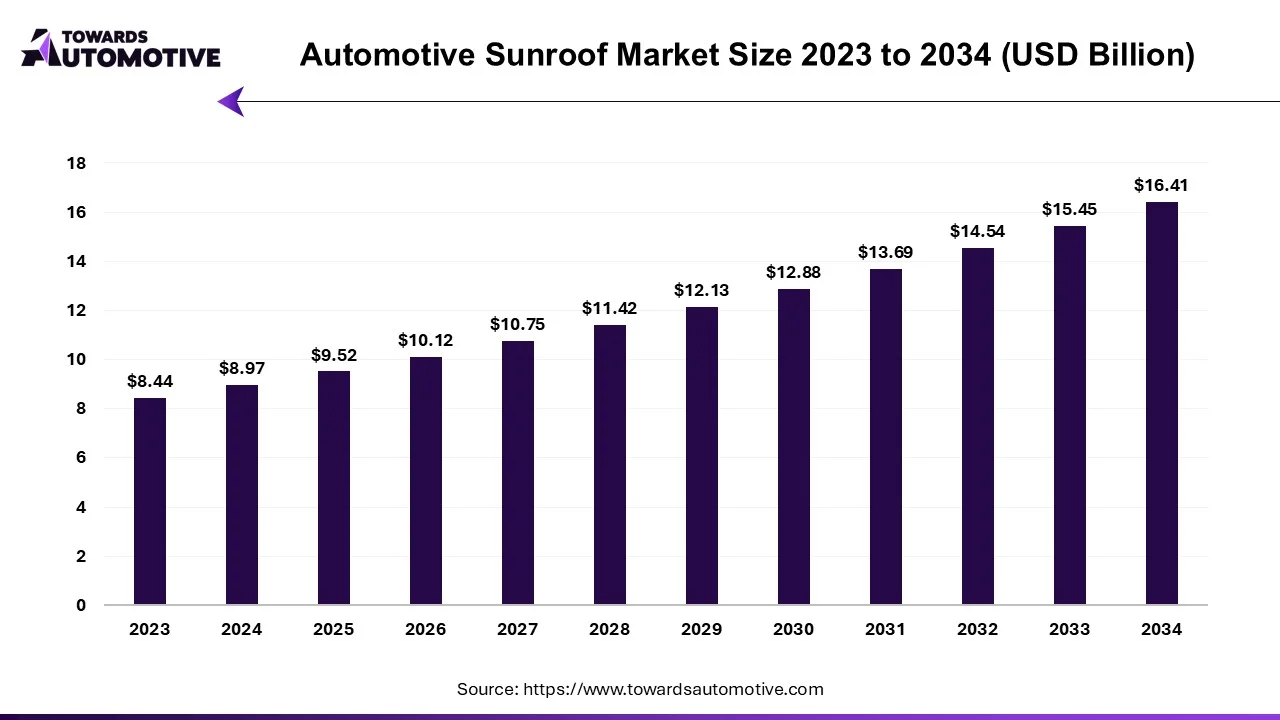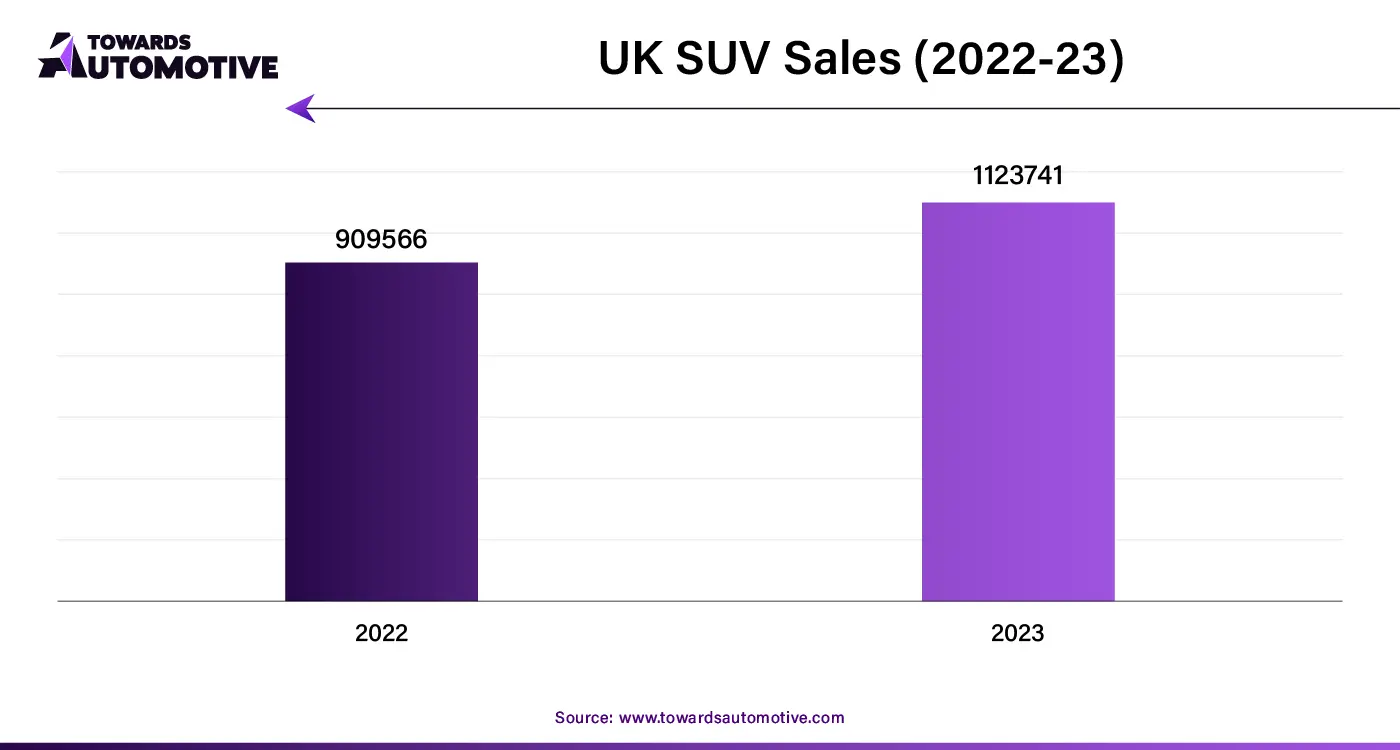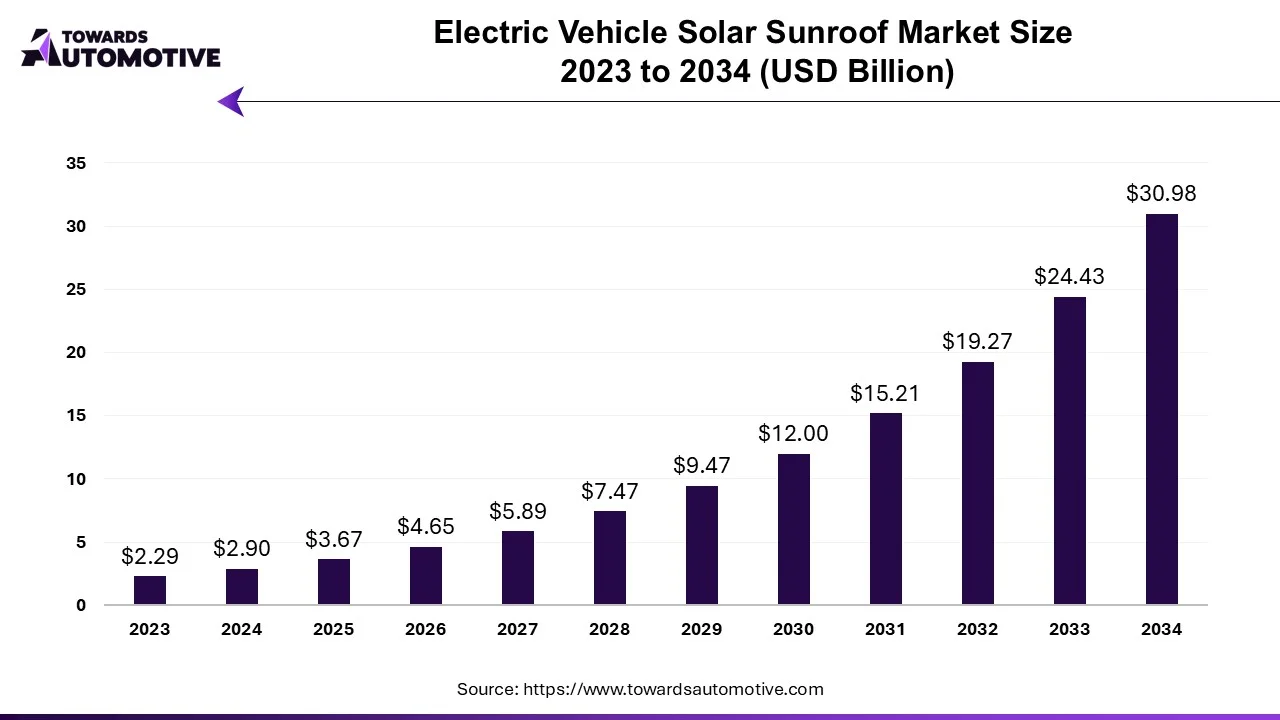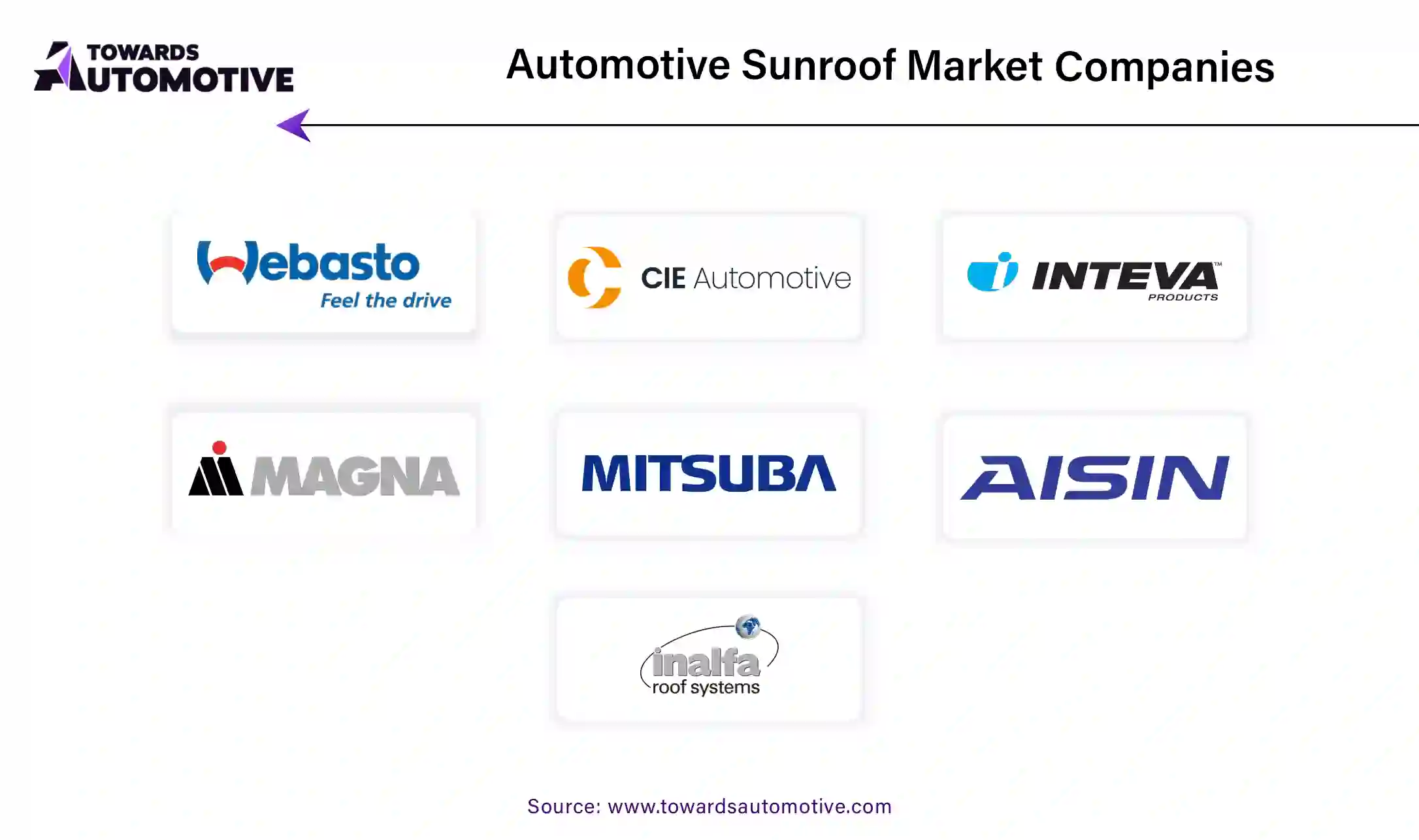October 2025
The automotive sunroof market is set to grow from USD 9.52 billion in 2025 to USD 16.41 billion by 2034, with an expected CAGR of 7.29% over the forecast period from 2025 to 2034.

The automotive sunroof market is a prominent branch of the automotive industry. This industry deals in manufacturing and distribution of sunroofs for the automotive sector. There are several types of sunroofs developed in this sector comprising of panoramic sunroofs, in-built sunroofs, tilt and slide sunroofs, pop-up sunroofs, top mount sunroofs and some others. These sunroofs are developed using various types of materials including glass and fabric.
It is designed for different types of vehicles consisting of ICE powered vehicles and electric powered vehicles. The growing use of sunroofs in SUVs is contributing to the industrial expansion. This market is expected to rise significantly with the growth of the automotive components industry around the world.

| Metric | Details |
| Market Size in 2024 | USD 8.97 Billion |
| Projected Market Size in 2034 | USD 16.41 Billion |
| CAGR (2025 - 2034) | 7.29% |
| Leading Region | Asia Pacific |
| Market Segmentation | By Vehicle Class, By Propulsion Type, By Material Type, By Product Type, By Operation Type and By Region |
| Top Key Players | Webasto Group (Germany), CIE Automotive (Spain), Inteva Products LLC (U.S.), Yachiyo Wuhan Manufacturing Co., Ltd. (Japan), Magna International Inc. (Canada), Mitsuba Corporation (Japan) |
| Source | Data Description | Year | Value |
| OICA | Global passenger vehicle sales | 2024 | 67,542,081 vehicles |
| SMMT | Electric vehicles registered in the UK (March) | 2025 (March) | 357,103 vehicles |
| Malaysian Automotive Association | Passenger cars sold in Malaysia | 2023 | 719,160 vehicles |
| Our World in Data | Global electric vehicle sales | 2023 | 13.80 million EVs |
The economical segment held a dominant share of the market. The rising demand for affordable vehicles in developing nations such as India, Vietnam, Indonesia and some others has boosted the market expansion. Additionally, the increasing sales of multi utility vehicles along with rapid investment by numerous automotive brands to launch economic cars is playing a vital role in shaping the industrial landscape. Moreover, the integration of pop-up sunroofs in mid-segment SUVs coupled with technological advancements in sunroofs is likely to drive the growth of the automotive sunroof market.
The luxury segment is likely to rise with the fastest CAGR during the forecast period. The growing demand for premium segment sedans in countries such as Germany, France, Italy, U.S., UAE and some others has boosted the market expansion. Also, the rising adoption of luxury SUVs among off-roading enthusiast along with increased use of panoramic sunroofs in luxury cars is further contributing to the overall industrial expansion. Moreover, partnerships and collaborations among several automotive brands and sunroof manufacturers for developing advanced sunroofs for premium cars is anticipated to propel the growth of the automotive sunroof market.
The ICE segment held the largest share of the market. The growing sales of diesel-powered vehicles in various countries such as U.S., Canada, UK, India and some others has boosted the market expansion. Also, the rising demand of high-performance vehicles along with rapid investment by automotive brands for developing ICE-based affordable cars is playing a crucial role in shaping the industrial landscape. Moreover, collaborations and joint ventures among automotive companies to develop fuel-efficient gasoline vehicles is driving the growth of the automotive sunroof market.
The electric vehicles segment is anticipated to witness the fastest growth during the forecast period. The growing demand for eco-friendly vehicles among the people to curb emission in the environment has driven the market growth. Also, the rising investment by EV manufacturers for developing luxury EVs to cater the needs of the elite-class consumers is contributing to the overall industrial expansion. Moreover, numerous government initiatives for developing the EV industry is further expected to propel the growth of the automotive sunroof market.
The panoramic sunroof segment dominated this industry. The growing use of panoramic sunroofs in luxury cars to enhance the travelling experience of passengers has driven the market growth. Also, the rising adoption of these sunroofs in modern cars due to its exceptional visibility is playing a crucial role in shaping the industry in a positive direction. Moreover, numerous advantages of panoramic sunroofs including improved ventilation, delivering natural light, enhanced view and some others is anticipated to propel the growth of the automotive sunroof market.
The in-built sunroof segment is predicted to rise with the highest CAGR during the forecast period. The rising use of moon roofs in electric vehicles has boosted the market expansion. Also, surge in demand for these sunroofs among several car manufacturers such as Audi, BMW, Mercedes and some others is shaping the industry in a positive direction. Additionally, built-in sunroofs come with several benefits such as enhanced ventilation, increased natural light, convenience and some others is projected to foster the growth of the automotive sunroof market.
Asia Pacific held the highest share of the automotive sunroof market. The growing sales and production of passenger vehicles in numerous countries such as India, China, Japan, South Korea and some others has boosted the market growth. Also, rising consumer interests towards luxury SUVs along with technological advancements in automotive sector is playing a vital role in shaping the industrial landscape. Moreover, presence of several automotive companies such as Tata Motors, Mahindra, XPENG, BYD, Toyota, Mitsubishi, Hyundai and some others is further driving the growth of the automotive sunroof market in this region.
China is the dominating country in this region. In China, this industry is generally driven by the rising production of passenger vehicles along with availability of raw materials at affordable rates. Additionally, the presence of several sunroof companies such as Zhejiang Wanchao Electric Co. Ltd, Fuyao Group, Shanghai Mobitech Technology Co., Ltd. and some others is likely to boost the market growth.
Europe is expected to grow with a significant CAGR during the forecast period. The rising adoption of electric vehicles in several nations such as UK, Germany, France, Italy and some others has boosted the market growth. Also, the growing adoption of luxury sedans among the rich consumers is likely to shape the industrial landscape. Moreover, the presence of several market players such as Webasto SE, Inalfa Roof Systems B.V., CIE Automotive and some others is expected to drive the growth of the automotive sunroof market in this region.
Germany held the highest share of the market in this region. The growing sales of premium cars along with technological advancements in automotive sector has boosted the market growth. Also, the presence of various automotive brands such as Mercedes, BMW, Audi and some others is further adding to the industrial expansion.
The electric vehicle solar sunroof market is anticipated to grow from USD 3.67 billion in 2025 to USD 30.98 billion by 2034, with a compound annual growth rate (CAGR) of 26.62% during the forecast period from 2025 to 2034.

The electric vehicle solar sunroof market is a crucial sector of the automotive components industry. This industry deals in manufacturing and distribution of solar sunroof for electric vehicles. There are several types of sunroofs developed in this industry comprising of fixed solar sunroof, retractable solar sunroof, solar panel integrated sunroof and some others. These sunroofs are developed using numerous materials including microcrystalline silicon, polycrystalline silicon, thin-film solar cells and some others. It is designed for different vehicles including passenger electric vehicles and commercial electric vehicles. The growing sales of EVs in different parts of the world has contributed to the industrial expansion. This market is predicted to rise significantly with the growth of the electric vehicle industry.
The automotive sunroof market is a highly competitive industry with the presence of a several dominating players. Some of the prominent companies in this industry consists of Magna International Inc, Inalfa Roof Systems Group, Automotive Sunroof Company, Bos Gmbh & Co. Kg, Webasto Roof Systems Inc, Yachiyo Industry Co.Ltd, Johnan America Inc, (Asc, Inc.), Inteva Products, Aisin Seiki Co., Ltd, Cie Automotive and some others.
These companies are constantly engaged in developing sunroofs for the automotive sector and adopting numerous strategies such as launches, partnerships, collaborations, joint ventures, acquisitions, business expansions and some others to maintain their dominant position in this industry. For instance, in December 2024, Inalfa Gabriel Sunroof Systems partnered with Dutch sunroof systems. This partnership is done for expanding sunroof manufacturing facilities in different parts of India.

By Vehicle Class
By Propulsion Type
By Material Type
By Product Type
By Operation Type
By Region
October 2025
October 2025
October 2025
October 2025
We offer automotive expertise for market projections and customizable research, adaptable to diverse strategic approaches.
Contact Us